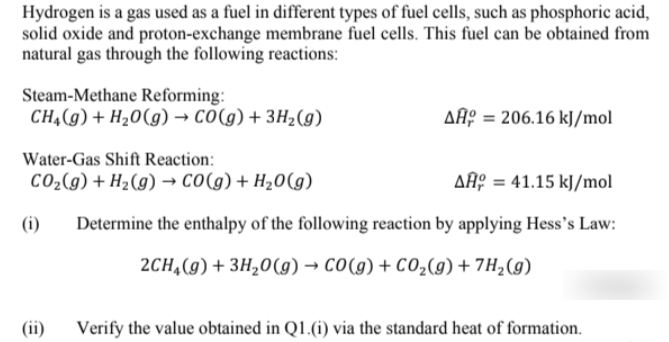Hydrogen is a gas used as a fuel in different types of fuel cells, such as phosphoric acid, solid oxide and proton-exchange membrane fuel cells. This fuel can be obtained from natural gas through the following reactions: Steam-Methane Reforming: CH,(g) + H20(g) → CO(g) + 3H2(g) AĤ¤ = 206.16 kJ/mol Water-Gas Shift Reaction: CO2(g) + H2(g) → CO(g) + H20(g) AĤÇ = 41.15 kJ/mol (i) Determine the enthalpy of the following reaction by applying Hess's Law: 2CH,(g) + 3H20(g) → CO(g) + CO2(g) + 7H2(g) (ii) Verify the value obtained in Q1.(i) via the standard heat of formation.
Hydrogen is a gas used as a fuel in different types of fuel cells, such as phosphoric acid, solid oxide and proton-exchange membrane fuel cells. This fuel can be obtained from natural gas through the following reactions: Steam-Methane Reforming: CH,(g) + H20(g) → CO(g) + 3H2(g) AĤ¤ = 206.16 kJ/mol Water-Gas Shift Reaction: CO2(g) + H2(g) → CO(g) + H20(g) AĤÇ = 41.15 kJ/mol (i) Determine the enthalpy of the following reaction by applying Hess's Law: 2CH,(g) + 3H20(g) → CO(g) + CO2(g) + 7H2(g) (ii) Verify the value obtained in Q1.(i) via the standard heat of formation.
Introduction to Chemical Engineering Thermodynamics
8th Edition
ISBN:9781259696527
Author:J.M. Smith Termodinamica en ingenieria quimica, Hendrick C Van Ness, Michael Abbott, Mark Swihart
Publisher:J.M. Smith Termodinamica en ingenieria quimica, Hendrick C Van Ness, Michael Abbott, Mark Swihart
Chapter1: Introduction
Section: Chapter Questions
Problem 1.1P
Related questions
Question

Transcribed Image Text:Hydrogen is a gas used as a fuel in different types of fuel cells, such as phosphoric acid,
solid oxide and proton-exchange membrane fuel cells. This fuel can be obtained from
natural gas through the following reactions:
Steam-Methane Reforming:
CH,(g) + H20(g) → CO(g) + 3H2(g)
AĤ¤ = 206.16 kJ/mol
Water-Gas Shift Reaction:
CO2(g) + H2(g) → CO(g) + H20(g)
AĤÇ = 41.15 kJ/mol
(i)
Determine the enthalpy of the following reaction by applying Hess's Law:
2CH,(g) + 3H20(g) → CO(g) + CO2(g) + 7H2(g)
(ii)
Verify the value obtained in Q1.(i) via the standard heat of formation.
Expert Solution
This question has been solved!
Explore an expertly crafted, step-by-step solution for a thorough understanding of key concepts.
This is a popular solution!
Trending now
This is a popular solution!
Step by step
Solved in 3 steps

Recommended textbooks for you

Introduction to Chemical Engineering Thermodynami…
Chemical Engineering
ISBN:
9781259696527
Author:
J.M. Smith Termodinamica en ingenieria quimica, Hendrick C Van Ness, Michael Abbott, Mark Swihart
Publisher:
McGraw-Hill Education

Elementary Principles of Chemical Processes, Bind…
Chemical Engineering
ISBN:
9781118431221
Author:
Richard M. Felder, Ronald W. Rousseau, Lisa G. Bullard
Publisher:
WILEY

Elements of Chemical Reaction Engineering (5th Ed…
Chemical Engineering
ISBN:
9780133887518
Author:
H. Scott Fogler
Publisher:
Prentice Hall

Introduction to Chemical Engineering Thermodynami…
Chemical Engineering
ISBN:
9781259696527
Author:
J.M. Smith Termodinamica en ingenieria quimica, Hendrick C Van Ness, Michael Abbott, Mark Swihart
Publisher:
McGraw-Hill Education

Elementary Principles of Chemical Processes, Bind…
Chemical Engineering
ISBN:
9781118431221
Author:
Richard M. Felder, Ronald W. Rousseau, Lisa G. Bullard
Publisher:
WILEY

Elements of Chemical Reaction Engineering (5th Ed…
Chemical Engineering
ISBN:
9780133887518
Author:
H. Scott Fogler
Publisher:
Prentice Hall


Industrial Plastics: Theory and Applications
Chemical Engineering
ISBN:
9781285061238
Author:
Lokensgard, Erik
Publisher:
Delmar Cengage Learning

Unit Operations of Chemical Engineering
Chemical Engineering
ISBN:
9780072848236
Author:
Warren McCabe, Julian C. Smith, Peter Harriott
Publisher:
McGraw-Hill Companies, The